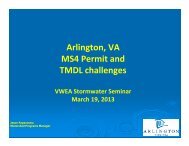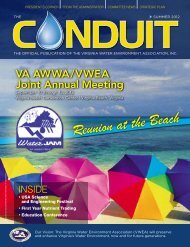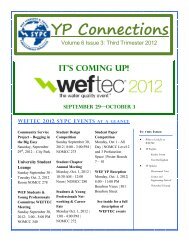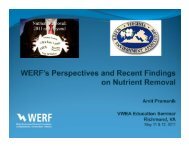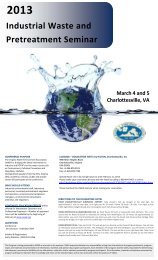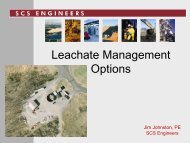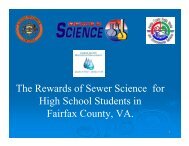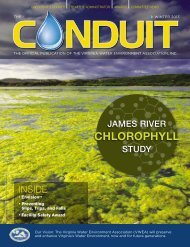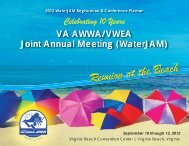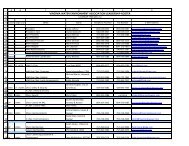bottled vs.tap: - Virginia Water Environment Association
bottled vs.tap: - Virginia Water Environment Association
bottled vs.tap: - Virginia Water Environment Association
- No tags were found...
Create successful ePaper yourself
Turn your PDF publications into a flip-book with our unique Google optimized e-Paper software.
were asked to describe six factors – appearance,odor, flavor, hardness/softness, mouthfeel, and aftertaste. Newport News <strong>Water</strong>workstook first place as the highest ratedsample, with Fairfax <strong>Water</strong> coming in a closesecond. It is interesting to note that boththese water plant facilities use ozone in thetreatment process. (Lab fact: ozone is knownto be effective in producing clearer water withreduced tastes and odors.)After the workshops there was a MexicanFiesta reception in the vendor exhibit area,which included a ticket bar. Attendees wereable to enjoy wonderful food, relax with arefreshing beverage, and talk with the exhibitorsabout their products.The second day of the event had 113attendees and consisted of a morning sessionwith two presentations and an afternoontechnical program consisting of 12 presentations.We were delighted to have GraceLeRose, VWEA president, graciously providethe opening welcome.The first morning presentation was givenby Joe Slayton of EPA on Laboratory QualitySystems. He is currently the senior scientistfor the USEPA Region III Regional Laboratoryin Fort Meade, Maryland (Office of AnalyticalServices and Quality Assurance, OASQA).He has been with the EPA for over 38 yearsas a biologist, microbiologist, physicalscientist, inorganic chemist, organic chemist,quality assurance officer, technical directorand senior scientist. Joe has performedmany thousands of analyses for the NPDES(National Pollutant Discharge EliminationSystem), SDWA, RCRA (Resource ConservationRecovery Act), and Superfund programsand has also served as a laboratory inspectorfor these same programs since 1979. He hasinspected many hundreds of permittee, commercial,state and federal laboratories andparticipated in the review of Region III Stateaccreditation and certification programs.Joe has also served on many nationalagency workgroups in such areas as:Superfund SOW, RCRA Organic Methods,NELAC/NELAP Quality Systems Committeeand Board of Directors, SDWA Lab CertificationManual, Detection Limit Policy, 304HCommittee for NPDES and the PBMS Committee.He has written numerous technicalarticles and guidance documents and hastestified as an expert witness in a number ofcivil and criminal cases.The second morning presentation wasgiven by Walter Higgins of EPA on the TheRoad to Zero Net Energy. Walter Higginsis an <strong>Environment</strong>al Scientist with EPARegion 3 and the Lead of the EPA Region 3Energy Team (focusing on energy efficiencyoutreach to WWTP staff and management).Prior to EPA, Walter worked for an environmentalengineering firm and an excavatingcompany performing various duties suchas public outreach on water quality, onsitesewage system evaluation, designs andinstallation. He also served for almost 10years as a soil scientist for the PA CountyHealth Department. He currently acts as aproject officer overseeing DE’s federal capitalizationgrant which funds the Delaware<strong>Water</strong> Pollution Revolving Loan Program.He also oversees the Special AppropriationAct Project which matches grants to localcommunities for wastewater, stormwater, anddrinking water improvement projects.The Tuesday afternoon technical programswere held concurrently in groups ofthree and covered the following topics:• Quality Control Checks & PerformanceStudies by Joe Slayton of EPA• PT Standards: Understanding, HelpfulInformation and Manufacturingby Henry Beauchamp of Phenova• Proficiency Testing Data Managementby Tanya Rahn of ERA• Advances in Lab WorkflowAutomation and Data Defensibilityby Jerry Lominac of PerkinElmer• When a Method is New to You:Incorporating Methods for HexavalentChromium and Perchlorate in Fairfax<strong>Water</strong>’s Repertoire by Susan Miller ofFairfax <strong>Water</strong>• Automation: the analysis of TotalAmmonia by Ion Selective Electrodeby Jeanine Miller-Nelson of Fairfax <strong>Water</strong>• Use of Defined Substrate Technologyfor Testing <strong>Water</strong> Samples: What is aNumber – MPN <strong>vs</strong>. CFU by Gil Dichterof IDEXX Labs• Toxicity CSI by Beth Thompson andLaura Shealy of Shealy Consulting, LLC• From Pilot to Full-ScaleImplementation: Methanol Additionto Denitrification Filters by LaurenZuravnsky of Greeley and Hansen• The Basics of <strong>Environment</strong>al SampleCollection by Lauren Grimmer of HRSD• Nutrient Measurement Using IonSelective Electrodes by Kelly Sweazeaof Thermo Scientific• Online Solid Phase Extraction forWastewater Analysis by Richard Jackand Joey Redovich of Thermo FisherScientific.The GLP Conference is always anexcellent opportunity to meet and networkwith fellow professionals from all over thecountry, have some fun, and fulfill any educational/trainingrequirements by earningCPEs (for wastewater and water operators)and CECs. There is always something foreveryone to take back with them to sharewith their colleagues. However, none ofthis would have been possible without thesupport of our sponsors and the hard workand dedication of our committee members.A very special thank-you goes out to the followingpeople for all their time and effort inhelping put this conference together: SherryWilliams (registration), Robin Parnell andKim Stubbs (programs), Alicia Connelly andWendy Harding (workshops), Chris Griffin(exhibits), Stuart Wilson (local arrangements),and Greg Hudson (LPC vice chair).Taste-testing table.Workshop.Exhibit area.Kathy Rabalais,the VWEA administrator.Exhibitor Gil Dichter with IDEXX.Fall 2012 – The Conduit19



